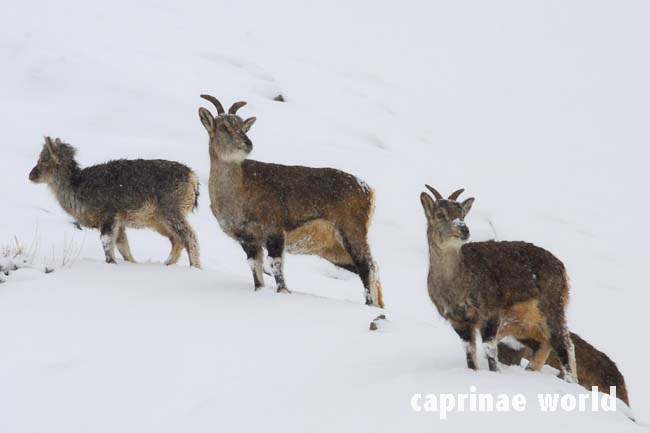The Tibetan Bharal is the nominate form of the Bharal. Brian Houghton Hodgson described the species 1833. The type locality is the Kachar region of Nepal.
Names
English: Tibetan Bharal, Himalayan Bharal [2], Naur, Nepal Blue Sheep [1]. Since Pseudois nayaur is in its own genus and closer related to Capra than to Ovis, the name „Blue Sheep“ is indefensible.
Chinese: 岩羊 [13, Wikipedia], Yanyang [13, 6, 1], banyang [1], Qingyang, Shiyang [6]
Dzongkha (national language of Bhutan): na or gnao [2]
French: Bharal du Tibet [2]
German: Tibet-Bharal [2]; formerly: Tibet-Blauschaf
Hindi: barhal, bharar and bharut [2], Burrhe [1]
Kullu (language spoken in Himachal Pradesh, India): Myatu [1]
Ladakhi: na and sna [2]
Nepali: nahoor or naur [1, 2], nahur [1]
Spanish: Baral del Tibet, capra azul del Himalaya [1], Baral del Himalaya [2]
Tibetan: gna‘-ba [2], Napu, na, nawa [1]
Taxonomy
Pseudois nayaur nayaur, Hodgson 1833
type locality: Tibetan frontier of Nepal (=Kachar region, Nepal) [2]
Distribution
by country/region: This subspecies of the Greater Bharal is found in Bhutan, Western China (mainly on the Tibetan Plateau), Northern India, Northern Myanmar (Rabinowitz and Tun Khaing 1998) and Nepal. [6]
Caprinae-world considers specimen from westernmost China, Northern Pakistan and Tajikistan – if they occur there at all – as Pamir Bharal.
In China the Tibetan Bharal occurs in Western Xizang AR (Aru County), extending eastwards in scattered populations to north-central Xizang. Good populations are in around the Qomolangma Feng National Nature Reserve especially the Karta, Gandun and Lapchi areas. The most easterly occurrence has been recorded in Jiangda, west of Jhinsha River at the border between Xizang AR and Sichuan Province. The northern and easten limits of the Tibetan Bharal range, where it meets the range of the Chinese Bharal, are undetermined and most likely comprise large intergrading zones. However following Damm and Franco (2014) Bharal occurring in Xizang AR are considered here as belonging to the nayaur race and those from the entire Qinghai Province and the areas further north and east as szechuanensis. [2]
In Bhutan the subspecies is found in the northern parts above 4.000 to 4.500 metres asl. [6]
In India it is fairly continuously distributed in the northern Himalayan and Trans-Himalayan regions, although the extent of its eastern distribution along the northern border of Arunachal Pradesh is still unknown. They are relatively common in many areas of eastern Ladakh (Jammu and Kashmir), and in parts of Spiti and the upper Parbati valley in northern Himachal Pradesh (Fox et al. 1986, S. Pandey pers. comm.). Tibetan Bharal are known to occur in the Govind Pashu Vihar Wildlife Sanctuary and Nanda Devi National Park, and near Badrinath (Uttar Pradesh), on the slopes of the Khangchendzonga massif (Sikkim), and in eastern Arunachal Pradesh. Very recently, Bharal presence has been confirmed in the northwestern corner of Arunachal Pradesh near its border with Bhutan and China. [6]
In Nepal, it is fairly continuously distributed to the north of the Greater Himalaya from the border with India and Tibet in the extreme northwest, eastwards through Dolpo and Mustang to Gorkha district in north-central Nepal. It then re-occurs in Nepal in at least two isolated areas: in Lamobogar, and on the southwestern slopes of Kanchenjunga near the border with Sikkim (India) (Schaller 1977, Wegge 1991). These two are probably connected with more extensive populations across the border in Tibet. [6]
Myanmar: Only in 1996 they were discovered in this country. Rabinowitz et al (1998) examined five sets of Bharal in the city of Putao, having reportedly come from the „icy mountains“ of the north. Bharal have never before been documented in Myanmar. [6]
Description
general appearance: The body is stocky, with stout legs, massive shoulders and broad chest. The pelage hair is short, thick and smooth. The typical beard of goats is absent and there is no fringe of hair on neck, throat or forelegs. [2]

head: long and narrow. [2]
ears: small and pointed. [2]
head-body: 160 cm [2]
shoulder height: males 90 cm [2] – Chinese Bharal max: 85 cm [2]
weight: males 54-68 kg [2] – Chinese Bharal (max of 7 rams): 61 kg [2]
tail: comparatively longer than in Asiatic sheep species [2]
Colouration / pelage
basic colour of back, sides and head: brownish-grey with a tinge of slaty blue (Lydekker 1907) [2]
summer ground colour: tending more to brown [2]
winter ground colour: tending more to grey washed with a whitish brown [2]
underparts: white [2]
black markings (position see below): get more pronounced with advancing age [2]; are also more pronounced in males
face: rams with greyish to black markings, especially on bridge of nose [2] and below and above the eye. Ewes lack the black markings [2].
chest: black [2], especially in rams; in females only on the lower brisket [2]
dark lateral stripe: seperates fawn coloured back from white underparts [2]; is broader in males; can be missing in females
legs: with dark stripes down the front of all four legs [2] – each black stripe actually wraps around the leg so that it can also be seen on inner and outer sides. The black is interrupted by a white patch on the „knees“ [2] (carpal joint!). Hind surfaces of the legs, as well as the buttocks, to the root of the tail, are pure white. [2]

tail: black [2]
Horns
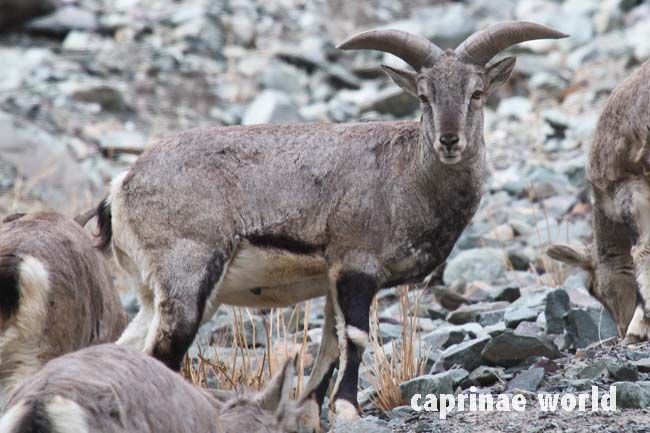
The horns of male Tibetan Bharal are rounded or sub-quadrangled in cross-section. Their surface is nearly smooth and devoid of wrinkles and grooves save for the annular growth rings and fine lines, as well as for cracks and other surface damage in older rams. [2]
colour: dark olive [2]
horns of ewes: short, closely approximated at their bases, much compressed; curving upward and outwards in a scimitar-like fashion [2]
curving of horns in males: first upward, then outward and finally incline inwards towards the neck over the withers. In Indian and Nepali populations some specimen can be found without up-turned tips. [2]
horn length: 63,5 cm (average of 159 specimens, collected between 1898 and 2009 [2] – Chinese Bharal: 57,8 cm [2]
basal circumference: 25,4-34 cm – Chinese Bharal: 25,4 cm [2]
tip-to-tip spread (mean): 56,2 cm (n=30), 55,9 cm (Nepal, n=7), 56,5 (India , n=23) – Chinese Bharal: 65,4 cm (Qinghai, n=15) [2]
tip-to-tip spread (maximum): 86,4 cm [2]
largest head harvested (Xizang – Tibet – AR, China 1904): length 84,5 cm,
Tibetan vs Chinese Bharal horns: horns of the Tibetan Bharal seem to be more massive (larger girth) in the second and third quarters than the Chinese Bharal, and on average also somewhat longer. However the tip-to-tip-spread is narrower in the Tibetan Bharal. [2]
Habitat
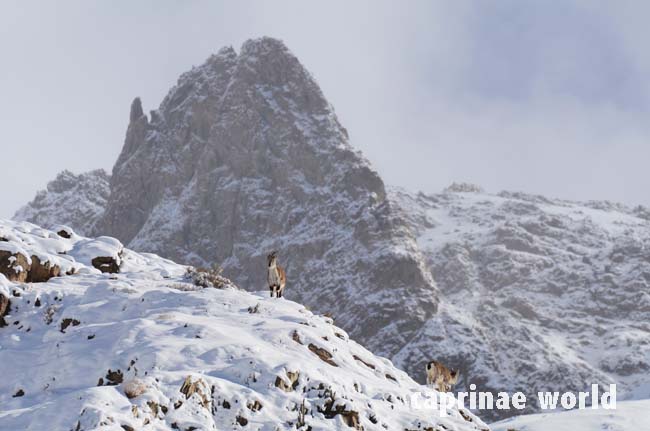
Mountain steppe country beyond the monsoon influence. Tibetan Bharal rarely occur below 4.500 metres. In summer they are readily observed at altitudes up to 6.500 metres. These gregarious animals inhabit precipitous, rocky terrain, using cliffs, talus slopes and caves for escape and cover. [2]
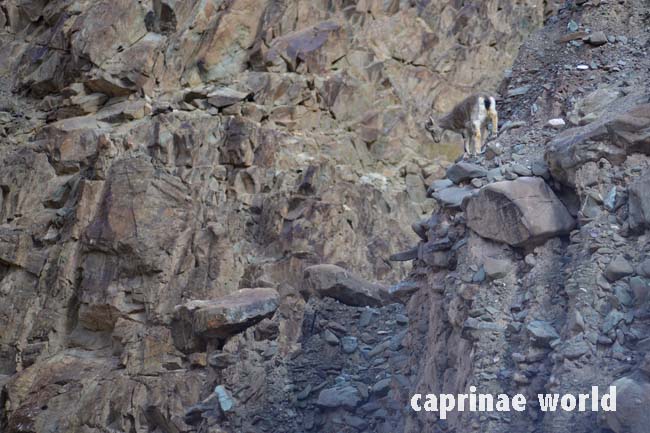
Food and feeding
see the corresponding paragraph in the Greater Bharal chapter
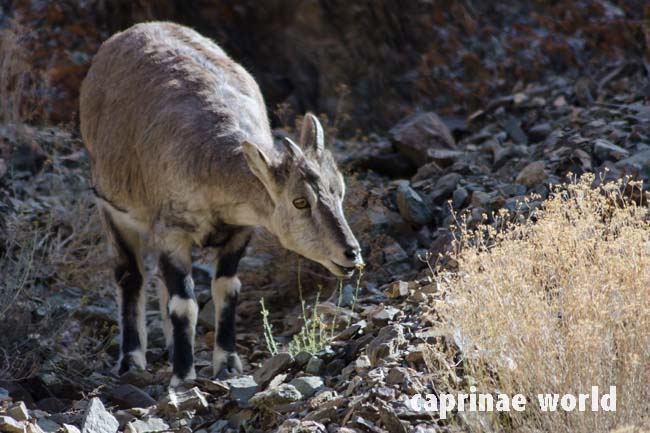
Breeding
mating season: October – January [2]
gestation: about 160 days [2]
offspring born: May to July [2]
Movements, home ranges and social organisation
Tibetan Bharal usually occur in mixed herds of several tens, sometimes as many as 200. Individual herds seem to occupy preferred territories. Mature rams usually keep to themselves. In spring and summer old rams seek higher elevations than the mixed herds, and join them again at the beginning of the rut. [2]

Status
IUCN classifies the species Pseudois nayaur under „least concern“. [6] The Tibetan Bharal may be considered as widespread and abundant. The populations throughout the range seem to be mostly healthy. [2]
In western China, P. nayaur was said to be “relatively abundant” (Shackleton 1997, Wang 1998), with various (questionable) local density estimates, and a total population greater than 10.000. The bulk of these 10.000 were an extrapolation for the Arjin Shan Nature Reserve, which is probably an overestimate. However, numerous areas within the current range were not included in this estimate, so the amount of 10.000 within the western portion of the Chinese range is not necessarily out of the question (Schaller 1998 guessed that at least 10.000 inhabited the Chang Tang Nature Reserve in western Tibet). Schaller (1998) cited an estimate by Pu (1993) of 34.500-49.600 in “western Tibet”, which includes but is larger than the Chang Tang Nature Reserve. [6]
Within India, Shackleton (1997) cites an estimate produced by Fox et al. (1991) of “a minimum of 11.000” within Ladakh. [6]
In Nepal, Shackleton (1997) reports a “conservative estimate of 10.000 animals”, although Schaller (1998) included a table suggesting 1.947-2.561 in areas counted within Nepal. [6] According to WWF the Bharal population in the Kangchenjunga Conservation Area (KCA) increased by 40 percent between 2007 (1.167 individuals) and 2015 (1.638). [0]
For Bhutan no estimates are available. [6]
Threats
China: Because access to Pseudois nayaur habitat is usually difficult and individual body-size is relatively small, market-based poaching for meat appears to be rare, at least in the northern portions of the Tibetan plateau. Locally-based, subsistence poaching has occurred frequently in recent years, and no doubt continues. However, China has recently begun implementing a new policy of confiscating all guns from nomadic pastoralists, and observations during 1998-2002 in Gansu and Qinghai provinces corroborate this (R. Harris pers. obs.). Thus, local herders now have little technology with which to poach P. nayaur for meat. [6]
In Bhutan, the species is not in immediate danger and numbers seem to be increasing due to the expansion of grazing areas for domestic yaks. However, heavy grazing by both species is damaging the fragile, high alpine vegetation, so Bharal population trends may be reversed in the near future. [6]
In India the major threat is localized over-hunting, including that by the army in remote outposts. Within Nepal, although in some areas religious beliefs protect Bharal from poaching, excessive competition from livestock grazing may cause habitat degradation in much of its natural range. [6]
Conservation
In China, the Tibet Bharal is present within a number of large protected areas such as the Chang Tang Nature Reserve (Schaller and Gu 1994), Medoq, Qomolangma and Zayu Reserves (Tibet); the Arjin Mountain Reserve (Achuff and Petocz 1988, Butler et al. 1986, Gu 1990) and Taxkorgan Reserve (Schaller 1977; Xinjiang); Kekexili and Sanjiangyuan Nature Reserves in Qinghai; and Yanchiwan and Qilian Nature Reserves (western Gansu). Some of these protected areas truly limit human disturbance, some have been demarcated where human disturbance was already quite low (generally because inhospitable climate makes production for human purposes marginal at best). Other protected area exist on paper only. Of note, however, is that, at least in China, P. nayaur appears able to persist at reasonable densities in the absence of protected areas. P. nayaur is categorized as a Class II protected species under China’s National Wildlife Law of 1988. [6]
In Bhutan, Bharal are known to occur in Jigme Dorji National Park. Conservation measures proposed by Wollenhaupt (1989) included, using input from local inhabitants, establishing integrated alpine forest and grassland reserves in high elevation areas where demand for domestic yak grazing is considerable and deforestation and degradation of alpine areas occur (Wollenhaupt 1989). [6]
In India, Bharal occur in several national parks and many other protected areas in northern India (Fox 1987; Fox et al. 1986, 1991; Gaston et al. 1981, 1983; Green 1987; Pandey in prep.; Singh et al. 1990) including: Jammu and Kashmir – Hemis National Park and Sabu Chukor Wildlife Reserve; Himachal Pradesh – Great Himalayan and Pin Valley National Parks and Chital, Daranghati, Kais, Kanawar, Lippa Asrang, Rakshum, Rupi Bhaba, Sangla Valley (includes previous Rakcha-Chitkul WS), Sechu Tuan Nala, and Tirthan (locally threatened) Wildlife Sanctuaries; Uttar Pradesh – Nanda Devi and Valley of Flowers National Parks, and Govind Pashu Vihar and Kedarnath Wildlife Sanctuaries; Sikkim – Khangchendzonga National Park; and their unlikely presence in Namdapha National Park of northeastern Arunachal Pradesh needs to be checked. [6]
Conservation measures proposed for India: 1) Establish the proposed Changtang, Gya-Miru, Karakoram, and Lung Nag Wildlife Sanctuaries (Jammu and Kashmir), and the extensions to the Great Himalayan National Park and the proposed Srikhand National Park (Himachal Pradesh). 2) Determine if Bharal occur along the northern border of Arunachal Pradesh. 3) Make the control of illegal hunting of this species the primary management priority to maintain viable populations under current land use regimes. 4) Monitor changes in livestock grazing practices that could affect competition with Bharal. [6]
In Nepal, Bharal are found in Shey-Phoksundo National Park and in the Annapurna Conservation Area. [6]
Conservation measures proposed for Nepal: 1) Maintain the current, closely controlled legal hunting program, and 2) consider a regulated program of sustainable, low-level subsistence hunting by local villagers in some areas. At the same time, 3) steps should be taken to halt or reverse the habitat destruction caused by livestock grazing in the Bharal’s natural habitat. [6]
In Nepal’s Kangchenjunga Conservation Area (KCA) the country’s first conservation area managed by a local community has been established. The Kangchenjunga Conservation Area Project (KCAP) was launched as a joint initiative of Department of National Parks and Wildlife Conservation (DNPWC) and WWF Nepal in March 1998. Four community based livestock insurance schemes and seven crop damage relief funds were established with support from KCAP which significantly contributed to reduce human-wildlife conflict and retaliatory killings of wildlife in KCA. Non-Timber Forest Products (NTFP) and ecotourism have been promoted to increase alternate livelihoods and economic opportunities in KCA. The Bharal population increased by 40 percent between 2007 (1.167 individuals) and 2015 (1.638). [0]
Hunting
International trophy hunting for P. nayaur occurs / occurred, but only in four to five designated areas in China and Nepal and Pakistan (For trophy hunting in Pakistan see the Pamir Bharal chapter), and in numbers too small to have substantial population impacts. International hunting (including for Bharal) in China was suspended in 2006, and as of summer 2014 had not yet been re-established. [6] Tibetan Bharal are also fully protected in India, Bhutan and Myanmar and may not be hunted legally in these countries. [2]
Nepal offers Bharal hunting in the Dhorpatan Hunting Reserve of Westcentral Nepal. This reserve is subdivided into seven blocks (Seng, Sundaha, Dogadhi, Barse, Fagune, Gutsang and Surtibang). The northern blocks are very remote. The reserve adjoins Myagadi and Baglung districts, just below the Dhaulagiri Range and encompasses an area of 1.325 km², with hunts taking place at elevations between 3.000 and 5.000 metres. Hunting season for Bharal in Nepal is October to November. [2]
Ecotourism
Many mammal watchers mention and value Tibetan Bharal, especially from Ladakh, India – see trip reports. It is the most frequently seen ungulate in this region. Pfister (2004) states that the best place to see it in Ladakh is Hemis National Park. [9] But apparently Hemis has become „too touristic“ (Eric Dragesco, pers. comm. 2020-05-14): „When a spotter has seen a Snow Leopard, after 15 minutes you have about 30 tourist arriving.“ On the other hand, if your target species is Bharal it should be possible to avoid the crowds.
Menon (2009) quotes that the species is best seen in India at Nanda Devi NP (Uttaranchal). [8]
In Nepal’s Kangchenjunga Conservation Area (KCA) ecotourism was promoted and developed as a source of income for local communities. Supporting tourism infrastructure, such as construction and maintenance of trails, campsites, toilets, community information centers, sign posts and information boards, and producing trekking guidelines and information was developed. Three tourist information centres, 14 km of trekking trails, six still/ irondeck bridges, 31 wooden bridges, a view tower and snow poles throughout the trekking trails were constructed. A total of 27 religious and cultural heritage sites were restored and maintained. Development of tourism-related microenterprises along the trails was facilitated. During the setup of the Kangchenjunga Conservation Area Project between 2007 and 2015 the Bharal population increased by 40 percent. [0]

Literature cited
[0] Bhandari, Ananta Ram et al, 2018: Kangchenjunga Conservation Area: A Retrospective Report, 2018. WWF Nepal.
[1] Castelló, José R., 2016: Bovids of the World – Antelopes, Gazelles, Cattle, Goats, Sheep, and Relatives. Princeton University Press
[2] Damm, Gerhard R. and Franco, Nicolás, 2014: The CIC Caprinae Atlas of the World – CIC International Council for Game and Wildlife Conservation, Budakeszi, Hungary in cooperation with Rowland Ward Publications RSA (Pty) Ltd., Johannesburg, South Africa
[4] Groves, Colin and Grubb, Peter, 2011: Ungulate Taxonomy. The John Hopkins University Press
[5] Grzimek, Bernhard (Hrsg.), 1988: Grzimeks Enzyklopädie, Säugetiere, Band 5. Kindler Verlag, München
[6] Harris, R.B. 2014. Pseudois nayaur. The IUCN Red List of Threatened Species 2014: e.T61513537A64313015. https://dx.doi.org/10.2305/IUCN.UK.2014-3.RLTS.T61513537A64313015.en. Downloaded on 25 May 2020.
[7] Matschei, Christian, 2012: Böcke, Takine & Moschusochsen. Filander Verlag
[10] Schaller, George B., 1977: Mountain Monarchs – wild sheep and goats of the Himalaya. The University of Chicago Press
[13] Smith, Andrew T. and Xie, Yan, 2008: A guide to the mammals of China. Princeton University Press
[16] Wilson, D. E. and Mittermeier, R. A. [eds], 2011: Handbook of the mammals of the world. Vol. 2. Hoofed mammals. Lynx Edicions, Barcelona.
